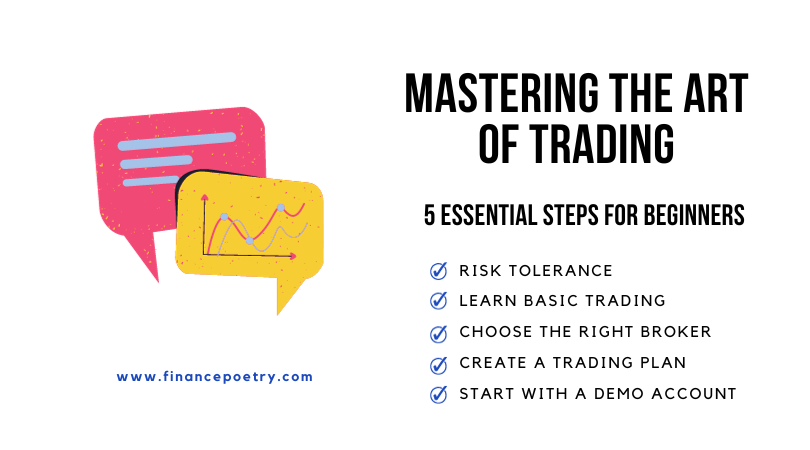Trading in the financial markets can be an exciting and potentially lucrative venture, but it’s also fraught with risks. Before you jump into the world of trading, there are several critical things you should know to increase your chances of success and minimize potential losses.

In this guide, we’ll explore the five essential factors to consider before you place your first trade.
1. Understand Your Risk Tolerance
Risk tolerance is a fundamental aspect of trading. It refers to your ability and willingness to endure fluctuations in the value of your investments. It’s crucial to assess your risk tolerance honestly before you start trading because it will influence your trading strategy and the assets you choose to trade.
Risk tolerance varies from person to person and can be affected by factors like your financial goals, investment horizon, and personal comfort level with risk. To determine your risk tolerance, ask yourself:
- How much money am I willing to invest?
- Am I comfortable with the possibility of losing a portion or all of my investment?
- What are my financial goals, and how does trading fit into them?
Once you have a clear understanding of your risk tolerance, you can tailor your trading approach accordingly. If you have a lower risk tolerance, you may opt for less volatile assets or employ risk management strategies like setting stop-loss orders.
2. Learn Basic Trading Concepts
Trading involves a range of concepts, strategies, and technical terms that you need to familiarize yourself with to make informed decisions. Some key concepts include:
a. Market Orders vs. Limit Orders
Understanding the difference between market orders (buying or selling at the current market price) and limit orders (buying or selling at a specific price or better) is essential for executing trades effectively.
b. Technical vs. Fundamental Analysis
These are two primary methods of analyzing assets. Technical analysis involves studying price charts and patterns, while fundamental analysis focuses on factors like financial statements, economic indicators, and news events.
c. Risk Management
Implementing risk management techniques, such as setting stop-loss orders and proper position sizing, is critical to protecting your capital.
3. Choose the Right Broker
Selecting the right brokerage platform is a crucial decision for any trader. Your broker will provide you with access to the financial markets, execute your trades, and offer various trading tools and resources. When choosing a broker, consider the following factors:
- Regulation: Ensure your chosen broker is regulated by a reputable financial authority to protect your funds and ensure fair trading conditions.
- Trading Platform: Evaluate the broker’s trading platform for user-friendliness, features, and compatibility with your trading style.
- Fees and Commissions: Be aware of the fees associated with trading, including spreads, commissions, and overnight financing costs.
- Customer Support: Access to responsive customer support can be invaluable when you encounter issues or have questions.
- Research and Educational Resources: Brokers that provide research reports, educational materials, and analysis tools can help you make informed trading decisions.
4. Create a Trading Plan
Successful trading requires a well-thought-out plan. A trading plan outlines your goals, risk management strategy, preferred trading instruments, and the criteria for entering and exiting trades. Here are key elements of a trading plan:
- Trading Goals: Define your financial objectives, whether they’re short-term or long-term. Your goals will shape your trading strategy.
- Risk Management: Specify how much of your capital you’re willing to risk on each trade and how you’ll implement risk-reduction techniques.
- Entry and Exit Strategies: Describe the conditions or signals that will prompt you to enter a trade (e.g., a specific price level or a technical indicator) and the criteria for exiting (e.g., a certain profit target or a stop-loss level).
- Position Sizing: Determine the size of each position based on your risk tolerance and the size of your trading account.
- Review and Adjust: Periodically review and adjust your trading plan to adapt to changing market conditions and to ensure it aligns with your goals.
A well-crafted trading plan helps you stay disciplined and avoid impulsive decisions that can lead to losses.
5. Start with a Demo trading Account
Before risking your real money, it’s wise to practice your trading skills with a demo account. Most reputable brokers offer demo accounts where you can trade with virtual funds in real market conditions. Here’s why using a demo account is beneficial:
- Skill Development: It allows you to gain experience and develop your trading skills without financial risk.
- Testing Strategies: You can test different trading strategies and refine your approach without incurring losses.
- Building Confidence: Trading can be emotionally challenging, and a demo account helps build confidence and emotional resilience.
- Familiarize with the Platform: It allows you to become comfortable with the trading platform and its features.
While trading on a demo account is valuable, keep in mind that real trading involves emotions and psychological factors that may not be present in a simulated environment.
In conclusion, trading can be a rewarding endeavor, but it’s not without its challenges.
By understanding your risk tolerance, learning key trading concepts, choosing the right broker, creating a trading plan, and starting with a demo account, you’ll be better equipped to navigate the complexities of the financial markets and increase your chances of success as a trader.
Remember that continuous learning and practice are essential for long-term trading success.
Here are some books you can refer :
Price Action Trading – Click here
Disclaimer: Any/all of the links on financepoetry.com are affiliate links from with I receive a small commission from sales of certain items. As an Amazon Associate, I earn from qualifying purchases. Thank you!